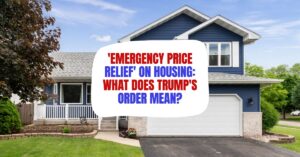“Trump Orders ‘Emergency Price Relief’ on Housing!” and you're probably wondering what that actually means. Let's cut through the political buzz and get to the heart of it. In short, President Trump has directed his administration to find ways to lower housing costs and increase the supply of homes. It's a move clearly aimed at tackling the affordability crisis, but the details, well, they're a bit hazy. This article dives deep into what this order entails, what it might mean, and what it definitely doesn't include.
I'm going to be honest, I've seen a lot of these kinds of announcements over the years, and while the intention sounds promising, the actual impact often falls short. But let's not be cynical just yet. We need to understand what's on the table, and where the real challenges lie.
‘Emergency Price Relief' on Housing: What Does Trump's Order Mean?
The Executive Order: A Cry for Affordability
Just hours into his second term, President Trump issued a memo directing all executive departments and agencies to take action aimed at lowering housing costs and boosting the housing supply. The memo states that hardworking families are overwhelmed by the cost of living, and that many Americans are unable to buy homes due to historically high prices. These aren't just empty words; we all feel this squeeze on our wallets.
The crux of the problem, according to the memo, is partly due to regulatory requirements that add a significant chunk to the cost of building a new home. Specifically, it claims that these regulations account for around 25% of the cost. Now, I’ve seen similar claims before, and frankly, figuring out exactly what constitutes “regulatory cost” can be a rabbit hole. But the general sentiment, that overly complex building processes add costs, definitely rings true.
The order mandates that executive branch leaders report their progress every 30 days, which implies a sense of urgency. However, the order is notably light on specifics. This leaves a lot of room for interpretation and, quite frankly, skepticism.
Here's a quick breakdown of what the order seeks to address:
- Lower housing costs.
- Expand the housing supply.
- Reduce other household expenses.
- Boost employment.
The Devil is in the Details… Or Lack Thereof
Okay, so we have this order, but what does it actually mean? Well, that's where things get interesting, or should I say, vague.
The memo mentions a “recent analysis” suggesting that regulations account for a substantial portion of new home costs. This refers to a 2021 study conducted by the National Association of Home Builders (NAHB). This study found that regulations add roughly 23.8% to the price of a new single-family home, with approximately 10.4% being from regulations imposed during development and 13.2% during the construction phase.
These are not small numbers, and, I agree that we need to do better when it comes to efficiency.
But here's the kicker: most of these regulations aren't federal. They are imposed at the state and local levels. This is where the real challenge lies. The federal government has limited power over those regulations.
Here's where it gets tricky:
- Federal Incentives, Not Mandates: The federal government can't just wave a magic wand and tell states and cities to change their rules. They can offer incentives – think grants or funding – to encourage streamlining, but they can't force the issue.
- State and Local Control: Building codes, zoning laws, and permitting processes are primarily decided by local authorities. This means that change will be a long and complicated process.
- Environmental Concerns: We can't just build everywhere. Environmental impact studies and concerns are legitimate and necessary. Ignoring them for the sake of construction would be shortsighted.
So, while the intention of cutting red tape is admirable, the execution will likely be difficult. There are powerful stakeholders who have vested interest in keeping rules the way they are, and often for very good reasons.
Opening Federal Land: A Possible Solution?
President Trump has also repeatedly mentioned the idea of opening up federal land for large-scale housing construction. The idea is that these would be ultralow tax and ultralow regulation zones, aiming to make building less expensive.
This idea, while intriguing, has both promise and limitations:
Potential Benefits:
- Increased Supply: It would definitely add to the number of houses that could be built, which, in theory, would help with demand.
- Lower Land Costs: Opening up existing government lands can reduce upfront costs for developers.
Challenges:
- Location, Location, Location: The problem is that much of the federal land is located in the Western US, far from major population centers. It’s not much help if the houses are built in places where people do not want to live or work.
- Infrastructure Needs: Even if we find land, these newly developed areas need roads, schools, hospitals, etc. The cost of these will add to housing costs.
- Environmental Concerns: Opening up any land for development would need environmental studies which also take time and money.
What the Order Doesn’t Address: Direct Assistance to Buyers
Notably absent from this order is any mention of direct assistance for homebuyers. This is in stark contrast to some other proposals, such as those that included tax credits or down payment assistance.
Why? Well, most economists (including me) agree that throwing money at buyers would just inflate prices. With supply constrained, more people bidding with more cash means the prices will just keep going up.
The focus on boosting the housing supply is, in my view, the right approach in the long run. It won't be a quick fix, but it's the more effective way to make homes affordable for all in the long term.
The Reality Check: My Take on the Situation
Let’s get real here. This executive order is more a statement of intent than a concrete plan. It highlights the problems – and that’s a start. But without specific actions and a willingness to tackle the complex web of regulations and local politics, it’s difficult to see how it will drastically change anything.
I’m not saying it’s hopeless. The fact that housing is a top priority on the president's agenda is important. But the road to affordable housing is long and complicated. It requires a multi-pronged approach, one that includes:
- Cutting regulatory red tape at all levels of government, with a focus on incentives for state and local reform.
- Opening up land thoughtfully, balancing the need for housing with environmental concerns and infrastructure.
- Promoting innovative building techniques that reduce costs without sacrificing quality or safety.
- Investing in workforce development to attract more people to the construction industry.
- Acknowledge the power of the supply and demand curves and act accordingly. We have to understand that the only way to create a fair market is to increase supply.
We also need to be realistic about timelines. These things take time and effort. We aren't going to see drastic changes overnight.
The Bottom Line
Trump’s order for “emergency price relief” is more of a starting gun than a sprint. It acknowledges the pressing need for more affordable housing, but the actual impact will depend heavily on the specific actions taken in the coming weeks, months, and years.
We need to hold our leaders accountable, and continue to push for real, meaningful solutions. Housing is a fundamental need, and it should be accessible to all.
Build a Stronger Future with Norada in 2025
As bold economic plans shape the nation, invest in high-quality, ready-to-rent properties for reliable returns.
Whether the focus is on growth or stability, real estate remains a cornerstone of financial security.
Speak with our expert investment counselors (No Obligation):
(800) 611-3060
Read More:
- Trump's Inaugural Speech: Bold Plans on Border, Economy, and More
- What Happens to Kamala Harris' Proposal of $25,000 Homebuyer Assistance Now?
- Housing Market Predictions for 2025 if “Trump” Wins Election
- 10 Housing Market Predictions Under Trump for the Next 4 Years
- Will Donald Trump's Victory Reshape the Housing Market in 2025?
- Trump vs Harris: Housing Market Predictions Post-Election



